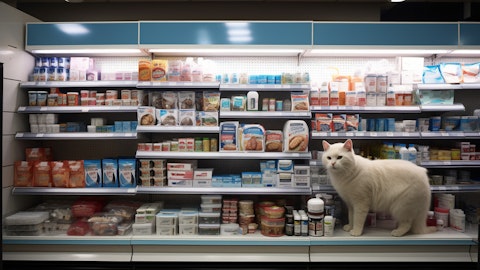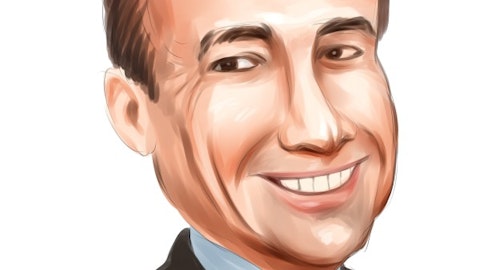Mark Smucker: I would — a couple of comments. I think the first is our categories have continued to perform very well in this environment. I mean you have this notion that within our categories, we play across the value spectrum. So we offer products that are — the consumer views as more value, whether it’s Folgers or traditional Milk-Bone, dog biscuits are obviously more affordable. We’ve also seen some of our premium offerings continue to perform well. So I think the breadth of our offering has served us well. We have a relatively low incidence of private-label competition, relatively lower than other categories in our what you have in our portfolio. So that’s been helpful. Even when you — in areas where you have seen some consumers shifting a bit, what I would might highlight is natural meat and pet.
So you see our Pepperoni brand, maybe a little bit softer than it has in the past. That’s indicative of the entire sort of Soft and Chewy pet snack category. So that’s not just us, but I think it’s across competition as well. That said, brands like Milk-Bone that have — that play across that value spectrum have actually been able to pick up the slack of where we have seen some maybe temporary softness in some of those other brands.
Alexia Howard: Great. Thank you very much. I will pass it on.
Operator: Thank you. Our next question today is coming from Steve Powers from Deutsche Bank. Your line is now live.
Steve Powers: Hey, thanks. Hi, Mark. Hi, Tucker.
Tucker Marshall: Good morning.
Steve Powers: Tucker — good morning. So Tucker, I don’t want to beat a dead horse, but I do want to go back to the stranded overhead, the conversation you were having earlier, and just play it back to you. I think a lot of the confusion on this point comes from — I think it was Slide 9 in your CAGNY deck when you gave a number of fiscal ’25 considerations. The way that slide reads is that is it’s a year-over-year impact, right? So all of the considerations on those slides are pluses and minuses relative to — it seems to ’24. Stranded overhead is a negative. And it’s confusing because as you said earlier, contract manufacturing and stranded overheads are independent considerations. And while there should be stranded overhead carryover from ’24 before it’s fully rationalized in ’26 and beyond, I guess I’m struggling from what you said earlier to see how it is worse than ’25 than in ’24.
So maybe you can just kind of — maybe I’m misinterpreting either the slide or your comments earlier, but just talk through how to think about stranded overhead specifically, if you could. Thank you.
Tucker Marshall: Yes. Absolutely, Steve. And we certainly appreciate that the Group is looking for clarity on this. We are doing our best without providing an estimate for FY ’25. But going back to this fiscal year, we have a net $0.60 impact to earnings per share as a result of stranded overhead. That net impact is total stranded overhead costs less by TSA income and reimbursement for services. So we will end our transition services agreement about midway through the fiscal year. So therefore, we will not be collecting the income associated with those services. Secondly is, we receive reimbursement for utilization of Smucker infrastructure, such as our distribution environment. And as a result of that, when ultimately post exits our distribution facilities, we won’t be receiving reimbursement.
So the company through our transformation office has begun to address stranded overhead this fiscal year for the benefit of next fiscal year, but there are certain activities that we can’t address until the TSA is completed, until they exit our distribution facilities, and we can rationalize some of that network. Steve, I hope that helps provide context just around the framework and the mechanics certainly appreciate you’re not the only one asking. So hopefully, that additional color is helpful to you and others.
Steve Powers: Yes, it does. So I think that — so let me just — so it sounds like the plug is that when you talked earlier about contract manufacturing, being essentially a zero margin activity. You weren’t including in that all of the other income considerations that you just spelled out. Fair?
Tucker Marshall: Contract manufacturing, considerations are independent of stranded overhead considerations, whether they be qualitative or quantitative.
Steve Powers: Understood. Very clear. Thank you so much.
Tucker Marshall: Absolutely. Thank you.
Operator: Thank you. Our next question today is coming from Pamela Kaufman from Morgan Stanley. Your line is now live.
Pamela Kaufman: Good morning.
Mark Smucker: Good morning.
Pamela Kaufman: I’m sorry to ask this again, but just to clarify, Steve’s question on stranded overhead. Do you expect the magnitude of stranded over cost — stranded overhead costs to moderate next year relative to the $0.60 impact this year? So that effectively creates a tailwind to year-over-year earnings growth.
Mark Smucker: Pam, I would love to tell you the number or the direction for next fiscal year, but that would be inappropriate until we finish our planning process. So unfortunately, we’ll have to do that on the fourth quarter earnings call. I’m sorry.
Pamela Kaufman: Understood. And then separately, will there be any wingering impact from the Uncrustables start up costs that impact 2025. And then can you just give an update on the progress that the transformation office has made? What have they been focused on? And what cost savings opportunities have they identified?
Tucker Marshall: As we ramp up Uncrustables production in McCalla, we will continue to see an impact associated with carrying overhead and a level of preproduction expenses we are still refining what that estimate will be. But the great thing about McCalla is it will be producing saleable sandwiches for the benefit of fiscal year ’25. As you think about our transformation office, we continue to be very pleased with our initial year where we’ve stood up the office where we’ve created almost 10 active work streams and support of cost and productivity savings in support of realizing synergies associated with the Hostess acquisition and also in support of addressing stranded overhead associated with the divested pet food brands.
And the exciting thing is it’s not only contributing dollars for reinvestment back into the business, but it’s supporting our earnings and earnings growth and delivery, but it’s also enabling new ways of working for our employees and cross-functional teams to really deliver great benefits to our company and organization.
Pamela Kaufman: Thank you.
Tucker Marshall: Thanks.
Operator: Thank you. Our next question today is coming from Rob Dickerson from Jefferies. Your line is now live.
Rob Dickerson: Great. Thanks so much. I don’t mean to — I’m just kidding. I just want to ask you a kind of broader question on Coffee. I guess, Mark, when we think historically the coffee business is always very strong. It’s been a consistent performer, operating margin kind of most of the time, let’s say, the majority of the time historically was coming in a little bit north of 30%. Totally understand at that point in time, input costs were a bit lower. But now I look at the business and think, okay, well, I mean Cafe Bustelo is clearly doing extremely well. Dunkin’ is still strong with new innovation platform. Folgers still take volume share to the largest brand. So it seems as if the business itself is in a good position, I mean, even on a relative basis across the category, you’re investing a little bit in price, but still pass-through category.
I’m just trying to right-size kind of like how you’re thinking about that margin profile, but just even say broadly speaking over the next couple of years, vis-à-vis kind of volume and price, right? Because volume is strong and pricing comes through usually kind of in a pass-through business, I would think there would be some fixed cost leverage that would allow you to start to recover kind of back to that 30%-plus profile, or just not there yet. So just curious as to how you’re thinking about that. Thanks.
Tucker Marshall: So Rob, as we think about the Coffee momentum through the year, the business continues to perform across the portfolio, and we’re very pleased with the brands and with the formats. To your point, we’ve seen Coffee margins improve. As we have gone through the fiscal year, particularly as we have lapped larger cost baskets and gotten into more normalized cost baskets. And so we continue to see the strength of the portfolio. I think we are focused on sort of the high 20s, as we’ve said in previous earnings calls in support of having healthy margins in the portfolio, but also in support of reinvesting in the business for the health and strength of our brands. And also as we think about our desired growth in liquid coffee.
And then furthermore, as we continue to think about the trajectory of coffee, we always assess the volatility in the green coffee market. And we also ensure that we are passing through pricing when appropriate and prudent, both on the upside and the downside of inflation or deflation. And then lastly is, the Coffee margin profile will continue to be strong in the fourth quarter. But then as we think about our first quarter of any fiscal year, it tends to be our sort of softer margin quarter of the full fiscal year.
Rob Dickerson: Okay. Fair enough. And then if I could just ask a fairly simple kind of dumb down question. In the Frozen Handheld and Spreads segment, you’ve clearly outlined kind of the revenue [indiscernible] per year over the next — I mean, this year and then over the next 2 years. So for modeling purposes, right, it’s easy enough to say, okay, well, let’s take what they finish this year in the segment and add $100 million, right? That’s Uncrustables, it seems like you have decent visibility on that. Are there any other puts and takes in that segment that could potentially get that segment, let’s say, higher than that incremental $100 million that you’ve already defined on Uncrustables and partially speaking to the innovation coming from Jeff and then I don’t know if they’re offsets on spreads. That’s all. Thanks a lot.
Tucker Marshall: Rob, we continue to be very excited about the trajectory of the Uncrustables venture brand and/or portfolio. We are still on track to the $1 billion ambition by the end of FY ’26, you have noted. We said directionally, on average, that might be about $100 million per year. I think right now, that’s where our focus is to ensure that we get to that ambition as we continue to build out traditional distribution channels and territories, along with new distribution channels as well. And so I think that, that’s probably the framework that I would use as you think about modeling the glide path of Uncrustables over the next several years.
Rob Dickerson: All right. Great. Thanks so much.
Operator: Thank you. Our next question is coming from Max Gumport from BNP Paribas. Your line is now live.
Max Gumport: Hi. Thanks for the question. First one is on Coffee. So on volume mix, it looked like it came in a bit better than we might have expected based on tracked channel trends during the quarter. I was hoping you could unpack the mix impact versus volume, and then also what you were seeing in tracked channels versus non-tracked channels? And how are those factors [indiscernible] your view on the fourth quarter? Thanks.
Tucker Marshall: Yes. So as we think about the third quarter performance on Coffee, we saw nice momentum from a volume mix standpoint. Obviously, we had the deflationary impact as a result of taking pricing, continue to be very pleased with the momentum on Cafe Bustelo and Dunkin’ along with our K-Cup portfolio. They all performed well in the quarter. Folgers also had a very strong quarter as well, but it was a little softer from a volume mix standpoint as we were lapping a key retailer activity in the prior quarter. And we continue to be very pleased with how we are considering the momentum into our fourth quarter as well.
Max Gumport: Thanks. And then on circling back to a slide you put up at CAGNY last week. So you laid out two tailwinds and three headwinds for your top line. Three of those are more — are not related to organic, two of them are, so continued brand momentum and inflationary pressures impacting consumers. Realize you’re not giving guidance yet for FY ’25, but as we think about those two factors, is there any reason to think one outweighs the other? I’m really just trying to get a sense for how that continued brand momentum could or could not be offsetting the inflationary pressures impacting consumers? Thanks. I will leave it there.
Tucker Marshall: Yes. Max, we have really strengthened the portfolio over the last several years with investments across our key brands, along with reshaping the portfolio. And so we feel very confident in the ongoing growth of the Uncrustables, Frozen Handheld, demonstrating category leadership and spreads, continuing to demonstrate at-home coffee leadership with the continued growth of the Cafe Bustelo, Dunkin’ and K-Cup portfolios. And then thinking about our pet momentum, as we think about Milk-Bone and also Meow Mix and then also the contribution from the Hostess acquisition, but to your point, back on the core portfolio. As it relates to just the impact of inflationary pressures associated with the consumers’ purchasing behavior, we continue to monitor and assess and understand what that means to our core portfolio.
But what we have seen over the last several quarters is continued growth across the portfolio and demonstrating volume growth. And our expectation is that we continue to demonstrate momentum.
Operator: Thank you. We’ve reached the end of our question-and-answer session. I’d like to turn the floor back over for any further or closing comments.
Mark Smucker: Thank you. Appreciate everyone joining the call this morning. It was actually great to see you all at CAGNY last week. And obviously, there, we were able to share our strategy more holistically and why we are so confident about the journey we’ve been on and the future of this business. Obviously, we hope you recognize the strong momentum in the third quarter, another great quarter for us and none of that would have been possible that are awesome employees. So I just want to take a moment to acknowledge our great employees, again, welcome the Hostess folks and the brands to our portfolio and just remain optimistic for the future and hope you all have a great day.
Operator: Thank you. That does conclude today’s teleconference and webcast. You may disconnect your lines at this time, and have a wonderful day. We thank you for your participation today.





